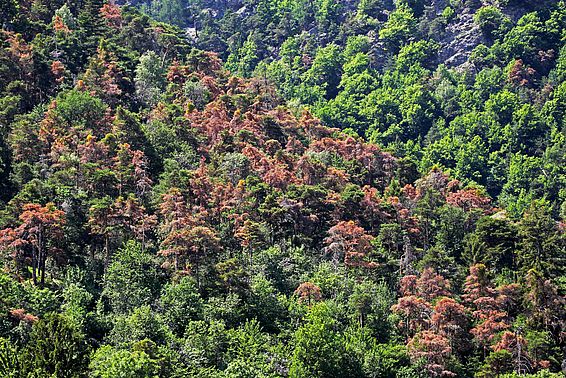14.06.2022 | Beate Kittl | News WSL
Since the 1990s, Valais and other dry Alpine valleys have seen repeated mass diebacks of Scots pines. Oddly, however, the amount of precipitation in the all-important summer months has not decreased at all over this period. WSL researchers have now found an explanation.
Large numbers of Scots pines have been dying on the mountain slopes of Valais since the 1990s. These mass diebacks aroused the curiosity of researchers since they were not confined to years of extreme heat and drought across Switzerland and Europe, such as 2003 or 2018, which might have explained the phenomenon.
A research team from the Swiss Federal Institute for Forest, Snow and Landscape Research (WSL) was keen to find out exactly what factors were responsible for these events. The researchers compiled data from four monitoring plots in the region, where the forest has been studied since the 1990s or early 2000s: Visp, Pfynwald, Saillon and Lens. The factors examined included crown defoliation (a key indicator of tree health), insect infestation, soil moisture and mistletoe infestation. In addition, extremes such as heat and frost events were determined based on rain, temperature, humidity, sunshine and wind data collected by MeteoSwiss since the 1980s.
Increased evaporation ¶
The result was surprisingly clear: "The sudden death of Scots pines can clearly be traced back to individual years with particularly dry summer months from July to September," explains Stefan Hunziker from WSL's Ecosystem Ecology Group. Factors such as insects or spring frost contributed to mortality in a few cases, but were not decisive. The sudden dieback of many trees occurred mainly in the area where rainfall in summer was often particularly low. In Visp, which had experienced several mass dieback events, all of them could be explained by a lack of rainfall in these months – despite the fact that summer months with very low rainfall have become neither more extreme nor more frequent over the past four decades.
This may seem like a contradiction, but global climate change has gathered pace significantly since the 1980s, raising air temperatures by around 2 °C in Valais in the spring and summer. At the same time, humidity has decreased and the number of sunshine hours has increased. As a result of these changes, Scots pines have been losing more water through their needles during photosynthesis and soils have dried out more in summer. While a short downpour may allow the trees to recover from the increased drought stress, in the absence of any rain the risk of severe damage or complete desiccation is high.
Poor outlook for Scots pine forests ¶
Similar sudden mass dieback events affecting Scots pines have also been seen in other dry Alpine valleys, as well as in countries such as Spain, Germany and Romania. "There too, precipitation in mid and late summer is probably the decisive factor," says Hunziker. In the future, rainfall quantities are likely to decline in summer, with water loss due to evaporation set to increase further. The people who manage these forests need to be ready for changes to the forest structure and species composition.
Scots pine is currently one of the commonest and most typical forest trees in Valais and Europe. As well as being used for timber, it is also the main species for protection forest on steep slopes. "The outlook for Scots pine forests at lower elevations in Valais is not good." Moreover, Valais and other dry Alpine valleys provide an early warning of the hotter, drier conditions that lie ahead for other regions too.
Always up to date: Subscribe to WSL Newsletter
Contact ¶
Publications ¶
Copyright ¶
WSL and SLF provide the artwork for imaging of press articles relating to this media release for free. Transferring and saving the images in image databases and saving of images by third parties is not allowed.


